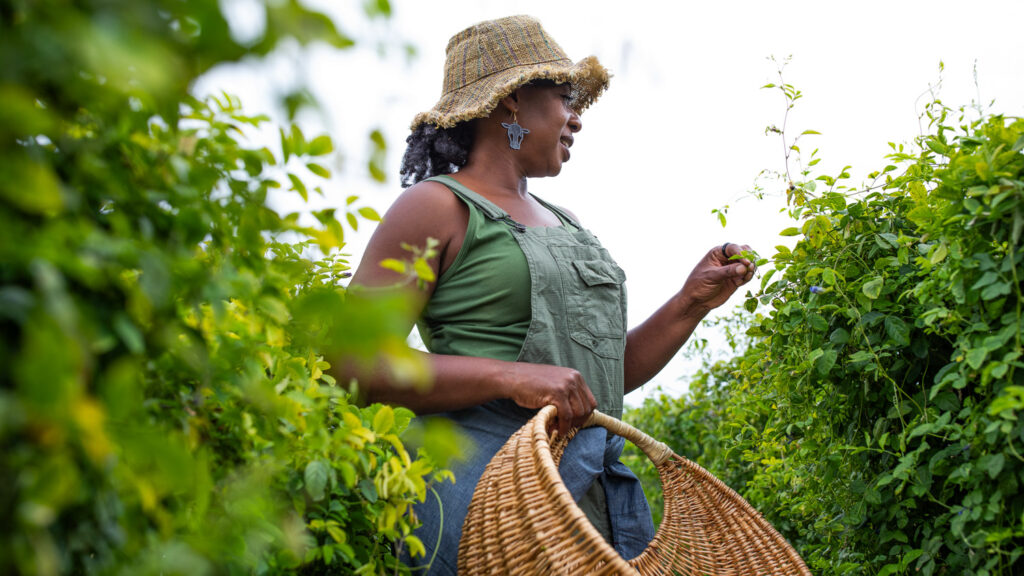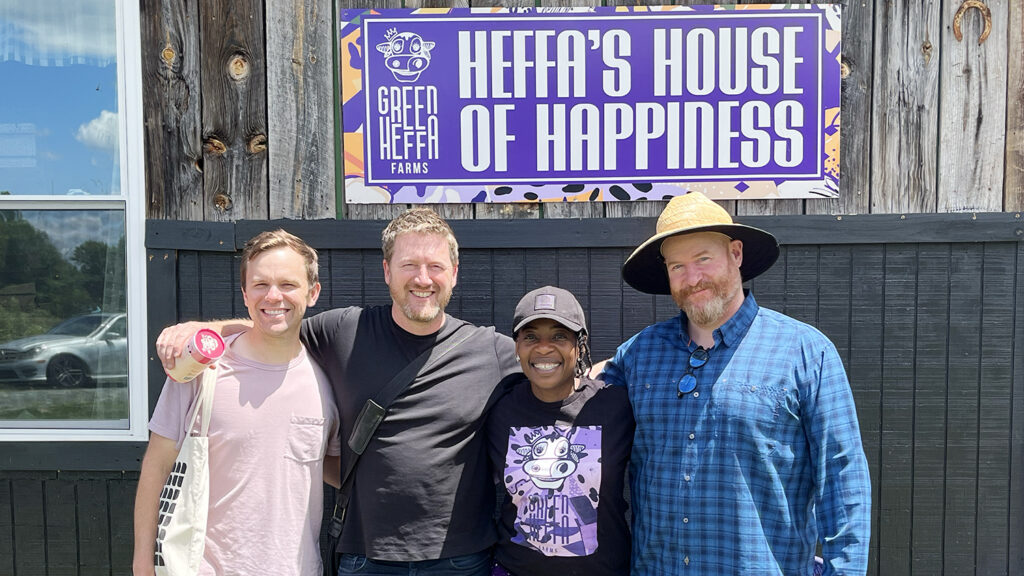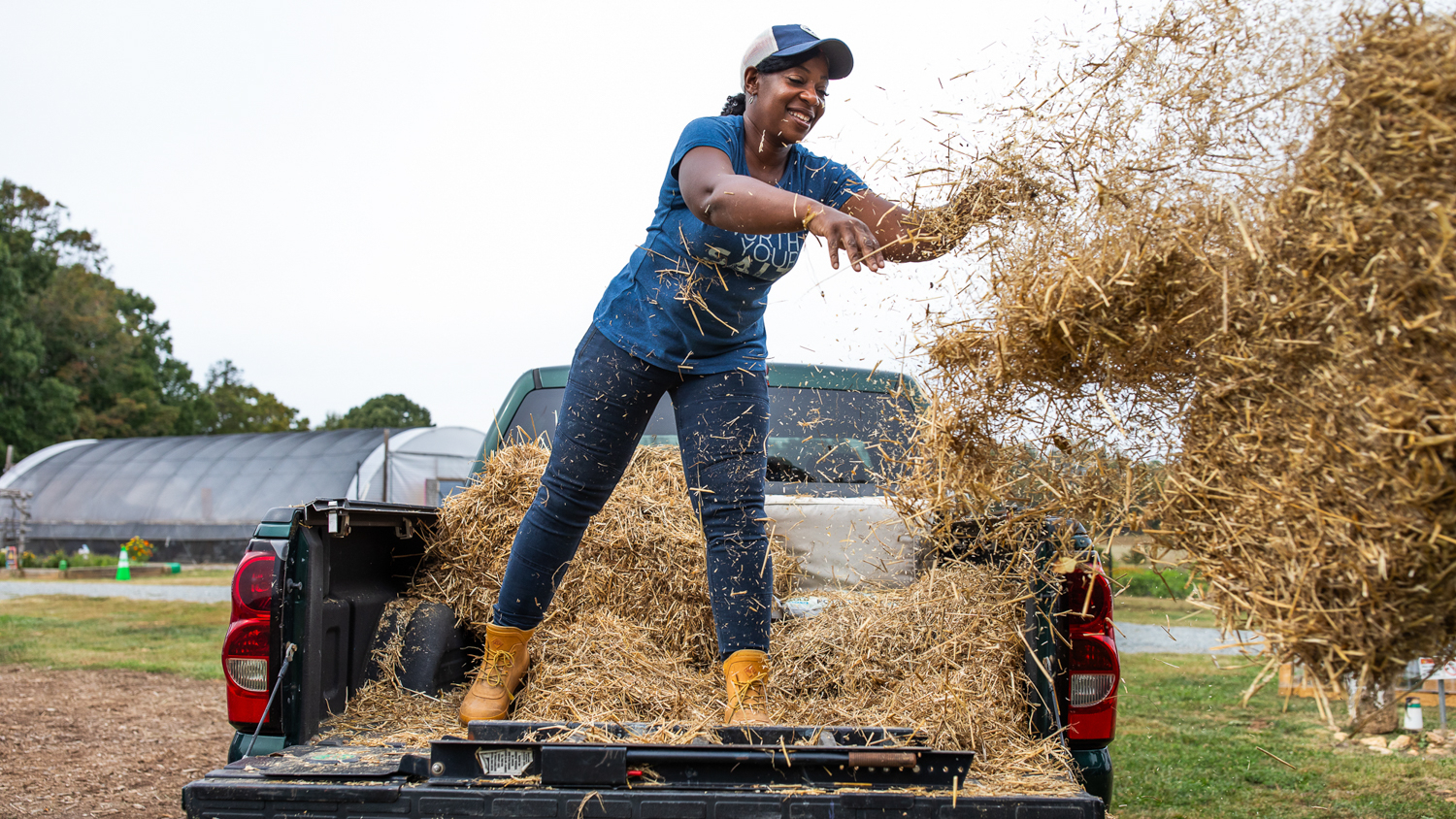Most students in Erin White‘s design thinking course, better known as D101, aren’t design majors. They come from all across campus with aspirations in marketing, computer science, horticulture, psychology, crop science and other disciplines. They’ve all made it from across NC State’s campus for one purpose – to solve wicked problems through design.
“Design thinking is a way to see problems in the world and generate and test new solutions that other disciplines often don’t have the tools for,” says White, who is a PhD student and instructor at the College of Design. “It’s an open-ended way of problem-solving that allows for imagination, creativity and innovation.”
In the spring of 2024, White and his students collaborated with Clarenda “Farmer Cee” Stanley of Green Heffa Farms in Chatham County. White first met Stanley in 2019 through a project at Shaw University that ultimately did not come to fruition. Since then, Stanley transitioned from her role as VP of development, advancing to a senior position in global environmental fundraising. She later pivoted to build Green Heffa Farms, a mission-driven farming brand focused on sustainable herbal products. Meanwhile, White began his PhD studies at the College of Design, reconnecting with Stanley to pursue their shared vision.
“I was beginning to plan for the next semester and thought about Cee’s entrepreneurial activities as a way to anchor the semester and at the same time make space for voices we don’t often hear from in design. She’s this accomplished, creative person who’s seen the world through many different lenses,” reflected White. “She’s been in higher education, she’s been in development, and she has built the first Black-owned farm in the U.S. to become a Certified B Corporation.”
White hoped that through Stanley’s diverse professional experiences and her intersectional lived experiences as a Black woman, she could help the class ask richer, more important questions about design and purpose.
“I wanted some fresh new ideas, innovation, and to help more young people think differently about agriculture, especially separating it from entrepreneurship,” says Stanley on the collaboration with the College of Design. “I wanted to help more young people think differently about agriculture. Educating them on the distinctions between being a farmer and being a farm owner, and all the responsibilities that come with land stewardship and brand building.”
Design Thinking Across All Disciplines

Design thinking is often associated with product design or architecture, but at NC State, the College of Design is proving that this methodology transcends traditional boundaries. The D101 course teaches students to approach problems holistically, encouraging them to consider human needs, environmental impacts and long-term sustainability.
White explains the value of this interdisciplinary approach: “What I find fascinating about this course is the diversity of students. They come from all over the university, from engineering to business to the humanities. It’s not just design students.” By learning to collaborate with individuals from different fields, students are prepared to adapt and excel in various industries after graduation.
Stanley and White felt that Green Heffa Farms would make a perfect example of how design thinking can be applied to industries outside the traditional design realm.
Stanley, an award-winning marketing and fundraising executive, turned to herb farming as a path to reclaim her peace and purpose after facing racial animus in her professional life. Embracing herb farming as a means to heal, Stanley has since built Green Heffa Farms—a sustainable, Black-woman-owned farm and consumer brand that embodies her values of environmental stewardship, equity and wellness. Through organic practices and a deep respect for the land, she has cultivated a thriving herb business that supports the health of her community while setting a powerful example of resilience and ethical entrepreneurship.
When she partnered with NC State students, they were tasked with helping her address key challenges, such as storage issues, workflow efficiency and social media strategy. This collaboration demonstrated to the students that design thinking isn’t just about creating products—it’s about finding innovative solutions for real-world problems in any context.
Community Engagement as a Learning Tool
One of the standout features of NC State’s College of Design is its commitment to incorporating community input into the curriculum. This is more than just a learning exercise—it’s an opportunity for students to collaborate with local entrepreneurs, nonprofits and small businesses to generate real impact. For the students in the D101 course, working with Cee Stanley provided a unique opportunity to apply their skills in a meaningful way, while also learning from someone with firsthand experience in their field of study.
Green Heffa Farms became a real-world classroom where students were able to see the challenges Stanley faced up close and personal. In one instance, Chelsy Posadas, a student majoring in graphic and experience design, worked on a solution to help Green Heffa Farms tackle its climate control issues.
As a rapidly expanding herb brand, the farm has faced challenges with limited storage and climate control issues that can lead to product spoilage. The farm’s growth has been driven by high demand for its climate-smart, organic and sustainably grown herbs, which often sell out faster than supply allows.
Posadas proposed an eco-friendly centralized workstation built from repurposed shipping containers, designed to be energy-efficient and climate-friendly. The solution incorporated solar panels, hemp insulation and a flexible, modular layout to accommodate future expansion—all while staying true to Stanley’s commitment to environmental sustainability.
“I gained the skill of taking initiative when creative problem-solving,” states Posadas. “Although I lacked knowledge in architecture or managing a farm business, by listening to Farmer Cee’s unique challenges and using research and curiosity, I landed on the workstation solution. It took multiple concept maps and pitch decks before landing on this one. Class presentations did not have strict right or wrong answers, but instead emphasized how non-linear the design process is.”
This hands-on experience gave students the technical knowledge to devise solutions and a deeper appreciation for the complexities of running a small agricultural business with a strong ethical foundation.
Laila Joi Major, a student from the College of Agriculture and Life Sciences, reflected on how design thinking helped her adopt an optimistic and non-linear mentality for breaking down daunting tasks by using the detangling of a necklace as a metaphor. “There is no specific order to untangle a necklace – you just need to find a knot to start with.”
Furthermore, Major emphasized the entrepreneurial mindset and personal experiences she learned from Stanley. “Cee was open about the realities of being a small Black-owned farm and the challenges that come with that. This project really broadened my view of what design can be. I’m now looking at how I can apply design thinking to issues beyond traditional design fields, like environmental and social challenges.”
Empathy at the Heart of Design

Perhaps the most important lesson the students took away from this course is the power of empathy in design. In their collaboration, the students learned that each challenge faced isn’t merely technical; it’s rooted in the powerful story and values of a business with a commitment to sustainable and equitable practices.
“Design thinking isn’t just for designing products or services—it’s a mindset that can be applied to any problem, whether it’s in business, agriculture or community-building.” – Erin White
Stanley’s desire to maintain the biodiversity on her farm, for instance, influenced every aspect of the students’ proposed solutions. This forced them to think critically about how their designs could honor her commitment to sustainability while still addressing the operational challenges she faced.
Erin White explained the broader implications of teaching design through an empathetic lens: “Design thinking isn’t just for designing products or services—it’s a mindset that can be applied to any problem, whether it’s in business, agriculture or community-building.” By prioritizing empathy, students were able to craft solutions that aligned with Stanley’s values and respected her vision for her farm.
Empathy also guided the students’ exploration of how design thinking could be applied beyond agriculture. In their conversations with Stanley, they realized that design is not just about solving problems—it’s about enhancing human experiences. Whether it was finding ways to improve storage space without damaging biodiversity, or suggesting strategies for boosting the farm’s online presence, the students learned that understanding the needs, aspirations and values of the people they were designing for was critical to their success.
Designing for a Better Future

The collaboration between the College of Design and Green Heffa Farms is a testament to the power of design thinking in transforming both education and community engagement. By working with real-world clients like Cee Stanley, students learn that design is not just about aesthetics or functionality—it’s about creating solutions that are empathetic, sustainable and innovative.
“”They weren’t just presenting abstract ideas; their solutions were practical and inspiring. In fact, one of their ideas has sparked real change here at Green Heffa Farms, and we’re actively working on implementing it.” – Cee Stanley
Since the spring, alumni Matthew Griffith, FAIA, and Zach Hoffman, AIA of in situ studio have joined the discussion with White and Stanley about the next steps for Green Heffa, helping imagine how ideas that come from the D101 course might materialize at the farm.
As the D101 course continues to grow, its emphasis on interdisciplinary learning and community involvement will continue to prepare students for success in a variety of fields. More importantly, it will instill in them the understanding that at the heart of every design process is a commitment to empathy—because in the end, good design is about improving lives.
“The students had the opportunity to meet with me virtually, where I shared the operations of our farm and gave them insight into the unique opportunities and strengths of running a small-scale, sustainable farm,” remarked Stanley. “They weren’t just presenting abstract ideas; their solutions were practical and inspiring. In fact, one of their ideas has sparked real change here at Green Heffa Farms, and we’re actively working on implementing it. It was exciting for them to see how their designs could directly impact the real world.”
This post was originally published in College of Design Blog.
- Categories:



